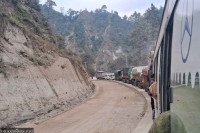Editorial
Medically unfit
Failure of Nepali medical students will ultimately lead to the failure of Nepal’s healthcare system.
A curious malady afflicts Nepal’s healthcare system. On the one hand, with its abysmal ratio of 0.8 health worker per 1,000 people, the country is in dire need of more medical professionals. One big reason for this shortfall is that over the years, the vast majority of those who have acquired medical degrees have failed to clear the medical licensing exams in which they must prove their proficiency to practice medicine. As per a recent Post report, as many as 58 percent of the MBBS and BDS doctors who took the licensing exam of the Nepal Medical Council (NMC) this year failed to get a pass mark. Worryingly, over the years, this kind of high fail rate has been more the norm than the exception.
In 2019, out of the 268 doctors who sat for one of the licensing exams, a whopping 146 failed. According to NMC officials, contributing to the high failure rate is the enrolment of underachievers who do not deserve to enter the medical profession and practise medicine, as well as students who do not take the exams seriously. The doctors who pursue medical degrees from foreign universities are also part of the problem. For many of these students, the sole goal is to get a medical degree, even if they have to spend a fortune in the process. The “investment”, they reckon, can be easily recouped with a degree in their hands.
Licensing exams filter out incompetent students with poor medical skills, preventing them from jeopardising public health. Underachievers entering a profession directly related to the health and wellbeing of people is a recipe for disaster. The failure of doctors in licensing exams has a long history, but what have the NMC and other relevant authorities done to address the underlying issues? It is vital that the council regulates haphazard and opaque admissions in MBBS and BDS programmes. Along with this, the medical colleges’ internal exams must also be rigorously monitored. The NMC and health authorities cannot get away by saying they don’t have the required manpower. If the government cannot invest a bit to save people’s lives, what good is it for? This is also why it would also be unjust to shift all the blame for the high failure rate only onto the students. At the end of the day, they can only be as good as the quality of education on offer.
Lack of proper monitoring and assessment has perennially plagued Nepal’s health education. The council should thus constantly check the quality of medical education on offer in addition to periodically assessing the teaching-learning environment. Also, there is no question of compromising on the quality of healthcare just to increase the number of doctors. Moreover, an equitable way out must be devised to make medical studies affordable to Nepali families with moderate and low incomes. The current trend of literally buying medical degrees must stop, and the certificates should rather go to the most deserving ones.
It will not be an exaggeration to say that the failure of Nepali medical students will ultimately lead to the failure of Nepal’s healthcare system.




 16.57°C Kathmandu
16.57°C Kathmandu














